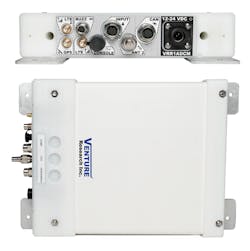The U.S. Navy, like other branches of the military, must keep track of critical assets around the world. To that end, it is hoping that a combination of wireless technologies will help to manage inventory. By working through a contract from the National Center for Manufacturing Sciences (NCMS), the Navy will receive mobile passive radio-frequency-identification (pRFID) systems for asset tracking at four geographically diverse sites. The MultiTrak mobile pRFID readers from Venture Research integrate GPS capability with a customizable API, enabling the Navy to evaluate the asset-tracking technology on a large scale.
Rugged MultiTrak mobile passive RFID readers with integrated GPS capabilities and customizable API are being evaluated by the U.S. Navy for worldwide asset tracking. (Courtesy: Venture Research)
The pRFID/GPS units are built for outdoor use, such as at naval piers, where it is hoped that they will improve asset-tracking efficiency. “We are pleased to be working with NCMS and the U.S. Navy to accurately track military and commercial assets through our unique solution that will improve inventory traceability and reduce wasted labor hours due to lost items,” said John Baker, president of Venture Research. “The American taxpayer will also see cost savings resulting from this implementation due to improved accuracy and reduction of redundant inventory.”
The Venture Research API and the integrated mobile pRFID asset tracking solution will be employed under the strictest military requirements, although the combination also holds promise for consumer and industrial asset tracking applications. Venture Research provides advanced solutions using GPS, pRFID, and Internet of Things (IoT) technologies to aerospace and defense customers, with products and services that have been used in more than 1,000 installations in 28 countries around the world.
About the Author
Jack Browne
Technical Contributor
Jack Browne, Technical Contributor, has worked in technical publishing for over 30 years. He managed the content and production of three technical journals while at the American Institute of Physics, including Medical Physics and the Journal of Vacuum Science & Technology. He has been a Publisher and Editor for Penton Media, started the firm’s Wireless Symposium & Exhibition trade show in 1993, and currently serves as Technical Contributor for that company's Microwaves & RF magazine. Browne, who holds a BS in Mathematics from City College of New York and BA degrees in English and Philosophy from Fordham University, is a member of the IEEE.

